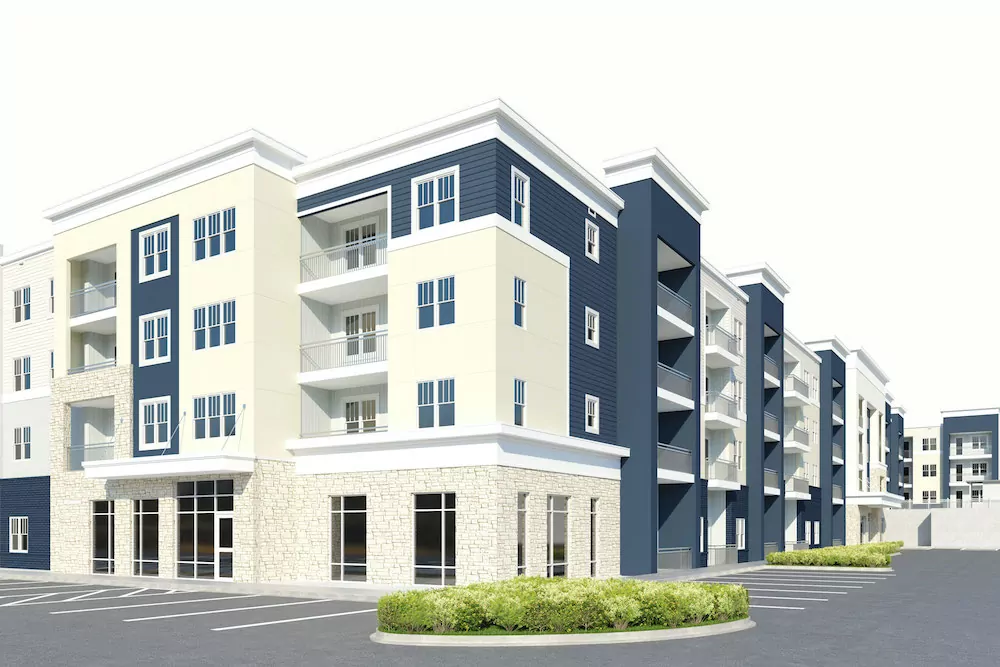Real Estate
Seizing the Opportunities: Investing in Senior Housing Amidst an Aging Population

As societies worldwide experience significant demographic changes, the rapidly aging population is one of the most pressing challenges. This demographic shift is reshaping various aspects of our society, including the need for adequate housing options for seniors. This article will explore the implications of this demographic trend and the opportunities for investing in senior housing.
The Aging Population: A Global Phenomenon
The world is witnessing an unprecedented increase in the proportion of elderly individuals within the population. Factors such as advancements in healthcare, declining birth rates, and longer life expectancies contribute to this demographic shift. Nations across the globe are grappling with the implications of an aging population and its multifaceted impact on various sectors, including housing.
The Demand for Senior Housing: A Growing Need
With the aging population comes an increased demand for senior housing. Many seniors prefer living in communities that cater to their specific needs, providing a safe, comfortable, and supportive environment. This demand is not limited to traditional nursing homes; it encompasses various housing options, such as independent living communities, assisted living facilities, memory care centers, and continuing care retirement communities.
The Economic Impact: A Lucrative Investment Opportunity
Investing in senior housing presents a promising opportunity for individuals and organizations alike. As the demand for senior housing continues to rise, so does the potential for financial gain. Furthermore, senior housing investments often contribute positively to local economies, generating employment opportunities and boosting economic growth.
Policy Considerations: Addressing the Needs of an Aging Population
Governments and policymakers play a crucial role in recognizing and addressing the housing needs of the aging population. It is essential to implement policies and regulations that facilitate the development of senior housing options, ensure affordability, and promote quality care and support services. Collaborative efforts between the public and private sectors can create an enabling environment for investment and innovation in senior housing.
The Rising Demand for Senior Housing: Current Trends and Future Projections
The increasing demand for senior housing is a significant driver for investment in this sector. This section will explore current trends and future projections that underline the growing need for senior housing options. Understanding these dynamics is crucial for investors seeking to capitalize on the opportunities presented by this expanding market.
Changing Lifestyles and Preferences
Today’s seniors seek housing options that align with their changing lifestyles and preferences. They desire independence, access to amenities, social engagement, and healthcare services tailored to their needs. Developers and operators of senior housing must adapt their offerings to meet these evolving expectations and provide a vibrant and fulfilling living experience for seniors.
Urbanization and Location Considerations
Urbanization plays a significant role in shaping the demand for senior housing. Many seniors prefer to reside in urban areas near healthcare facilities, cultural attractions, and social networks. Additionally, proximity to family and support systems is crucial to location decisions. As cities grow, investing in senior housing within urban centers presents an opportunity to cater to this demand.
Technology Integration for Aging in Place
Advancements in technology are transforming the senior housing landscape. Integrating smart home technologies, telehealth services, wearable devices, and monitoring systems allows seniors to age in place more comfortably and safely. Investors in senior housing should consider incorporating these technological innovations to enhance the living experience and attract tech-savvy seniors.
Sustainable and Age-Friendly Design
Recently, a growing emphasis has been on sustainable and age-friendly design principles in senior housing. Green building practices, energy efficiency, accessibility features, and well-designed communal spaces are becoming essential considerations for developers. Investments in environmentally conscious and age-friendly housing options align with societal expectations and contribute to long-term cost savings and resident satisfaction.
Future Projections and Market Growth
Future projections indicate that the demand for senior housing will continue to increase. The aging baby boomer generation and longer life expectancies ensure a sustained need for housing options that cater to seniors. Investors who recognize this long-term trend and position themselves strategically stand to benefit from the potential market growth and stable returns in the senior housing sector.
Investing in Senior Housing: The Financial and Societal Benefits
Stable and Recurring Income Streams
One of the primary financial benefits of investing in senior housing is the potential for stable and recurring income streams. Seniors typically sign long-term leases or contracts, providing a predictable revenue stream for investors. With proper management and occupancy rates, senior housing investments can generate consistent cash flow and deliver reliable returns over the long term.
Favorable Demographic Trends
Demographic trends, such as the aging population and increasing life expectancies, create a favorable market environment for senior housing investments. The growing demand for senior housing ensures a steady pool of potential residents, reducing vacancy risk and providing a solid foundation for sustained profitability.
Diversification of Investment Portfolio
Investing in senior housing offers an opportunity for diversification within an investment portfolio. By including senior housing as a component of a well-rounded investment strategy, investors can spread risk and reduce exposure to volatility in other sectors. The stability and resilience of the senior housing market make it attractive option for diversifying investment holdings.
Social Impact and Meaningful Contribution
Investing in senior housing goes beyond financial gains; it allows investors to make a positive societal impact. By providing high-quality housing options and support services, investors contribute to seniors’ well-being and quality of life. This sense of purpose and meaningful contribution can be rewarding and aligns with the growing focus on socially responsible investing.
Potential for Innovation and Technological Advancements
The senior housing sector offers opportunities for innovation and technological advancements. Investors can leverage emerging technologies to enhance the living experience of seniors, improve operational efficiencies, and create competitive advantages. Investing in senior housing allows for exploring new ideas and solutions to address the evolving needs of an aging population.
Challenges and Solutions in the Senior Housing Market
While investing in senior housing presents significant opportunities, it is essential to recognize and address the challenges that exist within the market. In this section, we will explore the key challenges faced in the senior housing sector and discuss potential solutions to overcome them, ensuring sustainable and prosperous investments.
Affordability and Accessibility
One of the main challenges in senior housing is affordability. Many seniors may struggle to afford housing and care services, especially as healthcare and living expenses continue to rise. Additionally, ensuring accessibility for seniors with mobility issues or disabilities is crucial. To address these challenges, developers and investors can explore financing options, subsidies, and innovative, cost-effective models that provide affordable and accessible senior housing solutions.
Regulatory and Compliance Requirements
The senior housing market is subject to various regulatory and compliance requirements. These include licensing, safety standards, healthcare regulations, and zoning restrictions. Staying informed and compliant with these regulations is crucial for investors and operators. Engaging with local authorities, obtaining necessary permits, and conducting thorough due diligence are vital steps to navigate this complex landscape.
Evolving Consumer Expectations
Consumer expectations within the senior housing market are continually evolving. Seniors are seeking personalized, high-quality care and modern amenities. Meeting these expectations requires ongoing investment in staff training, facility upgrades, and innovative service offerings. Investors must stay attuned to seniors’ changing needs and preferences to provide competitive and appealing senior housing options.
Operational and Management Challenges
Operating and managing senior housing facilities can present unique challenges. These can include staffing, healthcare coordination, maintenance, and resident engagement. Investors must ensure effective management strategies, including hiring qualified personnel, implementing comprehensive care plans, and fostering a supportive community environment. Partnering with experienced operators or hiring skilled management teams can help overcome these operational challenges.
Changing Healthcare Landscape
The integration of healthcare services within senior housing settings is becoming increasingly important. Seniors often require access to healthcare providers, medication management, and specialized care. Collaboration with healthcare organizations and professionals can help address this challenge, ensuring the delivery of comprehensive and coordinated healthcare services within senior housing facilities.
Future Outlook: Innovation and Growth Opportunities in Senior Housing
As the senior housing market continues to evolve, there are exciting opportunities for growth and innovation. In this final section, we will explore the future outlook for investing in senior housing and discuss the potential avenues for innovation, technological advancements, and meeting the evolving needs of seniors.
Technological Innovations and Aging in Place
Advancements in technology are poised to revolutionize the senior housing sector. From smart home automation and remote monitoring to virtual healthcare services and assistive devices, technology enables seniors to age in place with greater independence and safety. Investors can embrace these technological innovations to enhance the quality of life for residents, streamline operations, and differentiate their offerings in the market.
Sustainable and Green Senior Housing
Environmental sustainability is a growing priority across industries, and senior housing is no exception. Investors can seize the opportunity to develop environmentally conscious and energy-efficient senior housing communities. Incorporating sustainable design principles, renewable energy sources, and green building practices benefits the environment, attracts environmentally conscious seniors, and reduces long-term operating costs.
Integrated Healthcare and Wellness Services
The integration of healthcare and wellness services within senior housing communities is a trend that is likely to continue gaining momentum. Investors can explore partnerships with healthcare providers, offering on-site healthcare clinics, therapy services, and wellness programs. Senior housing communities can become holistic health and well-being hubs by providing comprehensive care and promoting active lifestyles.
Personalized and Lifestyle-Centric Offerings
Seniors increasingly value personalization and customization. Future investments in senior housing should prioritize offering a range of lifestyle-centric amenities and services. These can include fitness centers, spa facilities, social clubs, cultural activities, and educational programs tailored to the interests and preferences of residents. By focusing on individualized experiences, investors can create vibrant and engaging senior housing communities.
Intergenerational Living and Community Engagement
The concept of intergenerational living, where seniors and younger generations coexist and interact, is gaining recognition as a beneficial model. Investors can explore opportunities to incorporate intergenerational elements within senior housing communities, such as childcare facilities, shared common spaces, and collaboration with nearby educational institutions. Promoting community engagement and fostering meaningful connections across generations enriches the living experience for seniors.
Conclusion:
The future outlook for investing in senior housing is promising, with ample opportunities for innovation and growth. Technological advancements, sustainable design practices, integrated healthcare services, personalized offerings, and intergenerational living are key areas to focus on. By embracing these trends and adapting to the evolving needs of seniors, investors can create thriving senior housing communities that meet the demands of an aging population while delivering strong financial returns.
In conclusion, seizing the opportunities presented by investing in senior housing amidst an aging population requires a comprehensive understanding of the demographic shifts, current trends, financial and societal benefits, challenges, and future outlook. By strategically navigating these aspects, investors can contribute to providing high-quality housing options and support services for seniors while securing a profitable and sustainable investment venture.
Real Estate
Settling an Estate? Here’s How the Right Appraisal Can Streamline Probate


Settling an estate is perhaps one of the most difficult legal battles you are bound to deal with at some point in time or another. In case of unexpected situations, you find yourself charting an unfamiliar legal terrain where you have to make difficult decisions to ensure that you don’t fall under the legal knife. The defining element of settling an estate is the process of probate. It is a legal process that validates a deceased person’s will and ensures it is properly administered to distribute assets to beneficiaries, according to the deceased’s wishes. While the process of probate is long and tiring, one aspect that can help you smoothly come out of this process is a professional and court-compliant estate appraisal. It ensures that the real and accurate value of the estate in question is evaluated, which leads to the prevention of inaccurate tax filings or disputes among heirs.
A common misconception you may harbor is that you must be physically present for an estate appraisal. However, online appraisal is equally as efficient and ensures that you are getting the best services digitally. With professional appraisers, you can be assured of the fact that the estate is inspected extensively and sophisticated analytical techniques are used to find the accurate value. A complex process such as a probate demands paperwork explaining values down to each detail, and it is only through professional appraisers that you can provide a USPAP-compliant appraisal. The right appraisal can give you clarity when it is required the most and protect your estate from unnecessary delays, taxes, or liabilities. It can give your probate process a much-needed structure and objectivity, often absent in traditional probate processes.
In this article, we will understand how you can take help from an estate appraisal to streamline the process of selling an estate can immensely ease the process. You will realize that it is not just an option but rather a necessity that can offer you peace of mind and minimize legal as well as financial risk.
Simplify Probate and Protect the Estate with a Professional Appraisal


- Establishes Accurate Date-of-Death and Fair Market Value
When selling an estate, the IRS requires an accurate date of death and fair market value, which is essential in cases subject to federal estate taxes and also for estates that require equitable distribution or formal probate administration. A New York appraiser can help you prevent inaccurate values, IRS audits or penalties, delays in court approval of the inventory, rejection of tax filings due to non-compliance, and challenges by other heirs, beneficiaries, or creditors.
- Minimizes Family Disputes by Providing Objective, Third-Party Valuation
A professional appraisal ensures that a neutral and verifiable market-based value is provided that is free from emotional bias, transparency in asset allocation, especially when one heir wishes to buy out others, consistency with legal guidelines, and reduced exposure to claims of favoritism. It also provides a common basis for negotiation, which is vital, especially in blended families and complex estates. These appraisals create a solid foundation for mathematically equitable distribution and remove the possibility of subjective interpretations.
- Enables Strategic, Timely Decisions on Sale, Retention, or Transfer of Real Estate
With an accurate and detailed appraisal, you can gain confidence to list your property at the right price if you’re planning to sell. It can also provide clarity on whether it makes financial sense to retain or rent the property, insight into potential tax outcomes if the asset is liquidated, and legal documentation that supports fiduciary responsibility. You can unlock strategic and timely decisions on the sale of your estate and make decisions grounded in data, not assumptions.
- Supports Stepped-Up Basis Calculations and Protects Heirs From Future Tax Burdens
An estate appraisal can help establish the new cost basis. In the absence of an appraisal, the IRS may challenge the declared basis and trigger a much higher tax bill. The heir may also lack legal support if audited years later, and tax preparers won’t have a defensible figure to report gains or depreciation. With a USPAP-compliant appraisal, you ensure that precise property valuations are provided in legal proceedings.
- Adds Credibility and Efficiency to Legal and Probate Proceedings
An accurate appraisal from a professional appraiser can be formatted to match court inventory requirements, include zoning data, market trends, and comparable sales analysis, be signed and dated with supporting documentation that can be submitted with probate filings, and provide affidavits or testimony if required during contested proceedings. With audit-ready and court-compliant documents, you can save time and avoid delays.
End Note
With the right appraisal, you can streamline probate with confidence. It establishes an accurate date of death and fair market value, minimizes family disputes by providing objective and third-party valuation, enables strategic and timely decisions on sale, protects heirs from future tax burdens, and adds credibility or efficiency to legal and probate proceedings.
Read More: jacqulyn elizabeth hanley
Real Estate
3 Essential Tips for Choosing the Right Property Developer


A home is what most people purchase once in a lifetime. Having the ideal property that meets all your requirements and aligns with your vision is complex. Imagine a visionary mind who brings dreams to life, building communities and crafting spaces where memories are made. A property developer is what you call them.
They use their expertise to shape the landscape, create sustainable homes, and design environments loved by families, individuals, and communities. With their attention to detail and passion for architecture, property developer constantly explores ways to make a positive impact. What’s more, even make spaces with amenities promoting well-being, connectivity, and happiness.
In that sense, a property developer has a deep passion for transforming spaces into places and understanding your needs and desires, which will eventually call their developments “home.”
Hunt: Fundamental Steps
Before investing in a property development project, conducting thorough due diligence on the property developer is important. These steps can provide valuable information and help you decide about your property investment.
1. Website Browsing
Feel free to explore the developer’s website for a comprehensive insight into the company’s profile. By browsing the website, you can access valuable information about the company’s history, ownership, partners, operational timeline, and projects.
An overview of the company’s history, including its establishment, milestones, and achievements, may also be provided. This can help you know their experience and track record in the industry, presenting you with a sense of their credibility and reliability.
It’s also worth checking out the projects they’ve successfully delivered in the past and whether they met their promised deadlines. Searching for ongoing projects to see if they stay on track with their timelines is also helpful.
2. Review Completed Projects
When it comes to the world of real estate, there’s a saying that goes, “Seeing is believing.” To truly grasp the essence of a property, it’s important to go beyond the glossy brochures and virtual tours and visit the completed projects of the developers.
When evaluating a potential property development investment, visiting completed projects is crucial in your due diligence process. It allows you to see the actual result of the developer’s work, and it’s a chance to assess whether the property meets your expectations and standards.
One of the benefits of visiting completed projects is that you can see how the property has aged over time. Observe how well the developer has maintained the building, how the finishes have held up, and whether there are any signs of wear and tear. In addition, this also allows you to interact with existing residents or tenants, if possible.
3. Small Talk with Existing Owners
Chatting with a current property owner can quickly give you valuable insights about the developer. Ask them about their experiences on the property, satisfaction with the services, and any issues they may have encountered.
They can provide unbiased information about the pros and cons of working with the developer, the properties they offer, and how they operate. Ask about service standards, reliability, and other hidden aspects of property investment.
Verifying whether the layouts, finishes and build quality match what was presented in the marketing materials or sales pitch can also be done. This will help you avoid potential misrepresentations or discrepancies and make an informed decision based on real, tangible evidence.
Property Developer Checklist
Home purchasing demands careful consideration and thorough research to guarantee you make the right decision. One of the factors in making the right choice is determining a reputable developer.
They are responsible for the location, construction quality, pricing, and overall project value. This is why choosing a trustworthy developer and considering their background is very important. Here are a few things to keep on your checklist:
1. Their Background
Checking the developer’s background is crucial. Knowing about their history in the industry and the number of projects they finished, you can better understand their reputation and performance.
Real estate is a fiercely competitive industry, with developers aiming to meet client requirements through customized projects. The ability to adapt to changing market preferences plays a huge role in the success and survival of the industry. Their longevity in this field can speak volumes about their credibility.
2. Local Reputation and Track Record
Once you’ve grasped the available developers’ corporate profiles, look for the one with a solid reputation and a proven track record of successful projects. Glancing at their company’s record can give you the most accurate picture. Browse their company forums, news reports, press releases, and property sites for a comprehensive view.
It’s also good to check if the developer is a member or affiliated with industry associations or self-regulatory bodies. This shows their commitment to professionalism to industry standards. It’s like ensuring they’re part of a reliable community promoting good construction industry practices.
Read reviews, testimonials, and references from previous clients to determine their reliability, quality of work, and understanding of the local property market. Also, a thoughtful developer completes the project on time with strong commitment and unwavering dedication.
3. Quality
By physically walking through the completed projects, you can better understand the flow of the space, the quality of materials used, and the attention to detail. This can provide valuable wisdom into the developer’s commitment to quality and attention to maintenance and upkeep. It can be crucial in determining the property’s long-term value and potential return on investment.
Once you have confidence in the property developer’s reputation and track record for delivering projects on time, assessing the quality of their construction work is important. This includes evaluating the materials, craftsmanship, and attention to detail to ensure the property is built to a high standard.
Final Thoughts
Investing in property development can be a smart financial decision with numerous benefits. To name a few, these are wealth creation, economic growth, housing solutions, job creation, and community revitalization.
Choosing the right property developer is the reason behind the success of a property development project. Working with the right developer ensures the project is completed on time, within budget, and to the desired quality standards, minimizing risks and maximizing returns on investment.
References:
https://www.swagatgroup.in/blog/how-to-choose-the-right-real-estate-developer/
https://www.linkedin.com/pulse/5-tips-choose-right-property-developer-vascon-engineers/
https://micaraland.com/real-estate-ofws/news/finding-the-right-property-developer/
https://massrealestatenews.com/choosing-right-real-estate-developer/
https://www.camella.com.ph/things-to-check-in-a-real-estate-developer-before-buying-a-property/
https://muppaprojects.com/7-tips-to-choose-the-right-property-developer/
Real Estate
5 Budgeting Tips For Your Home Maintenance Needs


A home’s systems and appliances play a critical role in daily life, so it’s important to make sure they are performing as needed. Keeping track of the system’s age and any past repairs can help you anticipate future costs.
Experts recommend saving at least 1% of your home’s value per year to prepare for maintenance costs. However, this can vary depending on your home’s exact location. Better options include home warranty policies that can save a lot of money on costly repairs.
- Set a Goal
Keeping up with regular maintenance can lessen the need for costly repairs in the future. However, emergencies will inevitably arise and it’s important to prepare for them.
Many experts recommend saving 1 to 2% of your home’s value each year to cover unexpected expenses like a new roof or appliances. But, this number might not work for every budget.
A better option is to save a set amount each month for your home maintenance needs. This can help you avoid dipping into emergency savings and minimize your chance of going into debt to pay for unexpected repair costs. When setting up your budget, remember why you started and keep your goals in sight. This will help you stay motivated even on those days you don’t feel like budgeting.
- Set a Time Frame
Performing regular maintenance helps to keep everything in good working order. Even small fixes like caulking the tub and cleaning out the gutters can help prevent serious problems down the line.
Make a list of all the tasks that need to be completed and determine how often they should be done. It’s important to create a schedule that accounts for both the indoor and outdoor maintenance needs of your property.
Set reminders and use a calendar or list app to help you stay on track. If you prefer paper, try a notebook with dedicated spaces for each task.
- Make a Checklist
Keeping up with home maintenance tasks can be challenging, and it’s easy to miss important chores. Creating a checklist is a great way to keep track of these tasks and ensure they are completed on a regular basis.
Performing regular maintenance on your home can help prevent future damage and save you money. For example, cleaning out your dryer ducts each month can drastically reduce the risk of fires caused by lint buildup.
Similarly, resealing your windows can help increase the insulation of your home,
reducing how hard it has to work to maintain a comfortable temperature. This can save you a significant amount on energy bills in the long run.
- Make Small Contributions
When you save money for home repairs, it’s important to start small. Adding a few dollars a month to your savings can help ease the upfront cost of major projects like a new roof, sewer upgrade, or replacement appliances and systems.
Financial experts generally recommend homeowners set aside 1%-4% of their property’s value for upkeep and repairs. However, this number may vary depending on the age of your home and its current condition.
Consider opening a separate savings account to make it easier to resist the temptation to withdraw this money for other expenses. You can also use a budgeting app to track your spending and make it easier to stick to a savings plan. Try Experian Boost(r) to see how saving for home maintenance can impact your credit score.
- Set Up a Savings Account
As a homeowner, it is important to set aside money for routine maintenance and emergency repair expenses. A savings account is a good place to keep these funds. It’s also important to use an account that is easy to access, like a high-yield savings or money market account.
Many experts recommend saving 1%-4% of your home’s value. This method takes into account the age and condition of your house. It’s also a good idea to budget for one-time costs, such as lawn care and snow removal.
If you are planning on replacing your roof, for example, calculate how much it will cost and save accordingly. This will help you avoid hefty borrowing expenses. You should also consider the average yearly expenses for other maintenance items, such as HVAC repairs and paint touch-ups.
-



 Biography7 years ago
Biography7 years agoJacqulyn Elizabeth Hanley is the Mother of Liza Soberano?
-



 Home6 years ago
Home6 years agoEpson L3110 Driver Free Download Latest Updated Version
-



 Biography6 years ago
Biography6 years agoAmanda Levy Mckeehan Biography, Family, Net Worth, Age, Affairs, Facts
-



 Games4 years ago
Games4 years agoBest Free To Play MMORPG To Try This 2021
-



 Biography7 years ago
Biography7 years agoWho is Rose Dorothy Dauriac? Scarlett Johansson Daughter?
-



 Biography6 years ago
Biography6 years agoJessica Ditzel Secret Information that Nobody Knows | Joe Rogan’s Wife
-



 Home7 years ago
Home7 years agoLiza Soberano Biography, Age, Family and Boyfriends
-



 Biography7 years ago
Biography7 years agoWhat is the relation of Nathaniel Larry Osorno with Liza Soberano?































